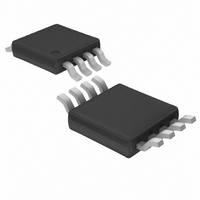LTC2602CMS8#TR Linear Technology, LTC2602CMS8#TR Datasheet - Page 10

LTC2602CMS8#TR
Manufacturer Part Number
LTC2602CMS8#TR
Description
IC DAC 16BIT DUAL R-R VOUT 8MSOP
Manufacturer
Linear Technology
Datasheet
1.LTC2622IMS8PBF.pdf
(16 pages)
Specifications of LTC2602CMS8#TR
Settling Time
10µs
Number Of Bits
16
Data Interface
Serial
Number Of Converters
2
Voltage Supply Source
Single Supply
Power Dissipation (max)
6.5mW
Operating Temperature
0°C ~ 70°C
Mounting Type
Surface Mount
Package / Case
8-MSOP, Micro8™, 8-uMAX, 8-uSOP,
Lead Free Status / RoHS Status
Contains lead / RoHS non-compliant
Available stocks
Company
Part Number
Manufacturer
Quantity
Price
LTC2602/LTC2612/LTC2622
OPERATIO
Power-On Reset
The LTC2602/LTC2612/LTC2622 clear the outputs to zero
scale when power is first applied, making system initializa-
tion consistent and repeatable.
For some applications, downstream circuits are active
during DAC power-up, and may be sensitive to nonzero
outputs from the DAC during this time. The LTC2602/
LTC2612/LTC2622 contain circuitry to reduce the power-
on glitch; furthermore, the glitch amplitude can be made
smaller by reducing the ramp rate of the power supply. For
example, if the power supply is ramped to 5V in 1ms, the
analog outputs rise less than 10mV above ground (typ)
during power-on. See Power-On Reset Glitch in the Typi-
cal Performance Characteristics section.
Power Supply Sequencing
The voltage at REF (Pin 4) should be kept within the range
– 0.3V ≤ V
Ratings). Particular care should be taken to observe these
limits during power supply turn-on and turn-off sequences,
when the voltage at V
Transfer Function
The digital-to-analog transfer function is
where k is the decimal equivalent of the binary DAC input
code, N is the resolution and V
(Pin 4).
Table 1.
COMMAND*
ADDRESS (n)*
*Command and address codes not shown are reserved and should not be used.
10
C3 C2 C1 C0
A3 A2 A1 A0
0
0
0
0
0
1
0
0
1
V
OUT IDEAL
0
0
0
0
1
1
0
0
1
(
0
0
1
1
0
1
0
0
1
REF
0
1
0
1
0
1
0
1
1
)
=
≤ V
⎛
⎜
⎝
U
Write to Input Register n
Update (Power Up) DAC Register n
Write to Input Register n, Update (Power Up) All n
Write to and Update (Power Up) n
Power Down n
No Operation
DAC A
DAC B
All DACs
2
CC
k
N
CC
⎞
⎟
⎠
+ 0.3V (see Absolute Maximum
V
REF
(Pin 6) is in transition.
REF
is the voltage at REF
Serial Interface
The CS/LD input is level triggered. When this input is taken
low, it acts as a chip-select signal, activating the SDI and
SCK buffers and enabling the input shift register. Data
(SDI input) is transferred at the next 24 rising SCK edges.
The 4-bit command, C3-C0, is loaded first; then the 4-bit
DAC address, A3-A0; and finally the 16-bit data word. The
data word comprises the 16-, 14- or 12-bit input code,
ordered MSB-to-LSB, followed by 0, 2 or 4 don’t-care bits
(LTC2602, LTC2612 and LTC2622 respectively). Data can
only be transferred to the device when the CS/LD signal is
low.The rising edge of CS/LD ends the data transfer and
causes the device to carry out the action specified in the
24-bit input word. The complete sequence is shown in
Figure 2a.
The command (C3-C0) and address (A3-A0) assignments
are shown in Table 1. The first four commands in the table
consist of write and update operations. A write operation
loads a 16-bit data word from the 32-bit shift register into
the input register of the selected DAC, n. An update
operation copies the data word from the input register to
the DAC register. Once copied into the DAC register, the
data word becomes the active 16-, 14- or 12-bit input
code, and is converted to an analog voltage at the DAC
output. The update operation also powers up the selected
DAC if it had been in power-down mode. The data path and
registers are shown in the block diagram.
While the minimum input word is 24 bits, it may optionally
be extended to 32 bits to accommodate microprocessors
which have a minimum word width of 16 bits (2 bytes). To
use the 32-bit word width, 8 don’t-care bits are transferred
to the device first, followed by the 24-bit word as just
described. Figure 2b shows the 32-bit sequence.
Power-Down Mode
For power-constrained applications, power-down mode
can be used to reduce the supply current whenever less
than two outputs are needed. When in power-down, the
buffer amplifiers, bias circuits and reference inputs are
disabled, and draw essentially zero current. The DAC
outputs are put into a high-impedance state, and the
2602fa













